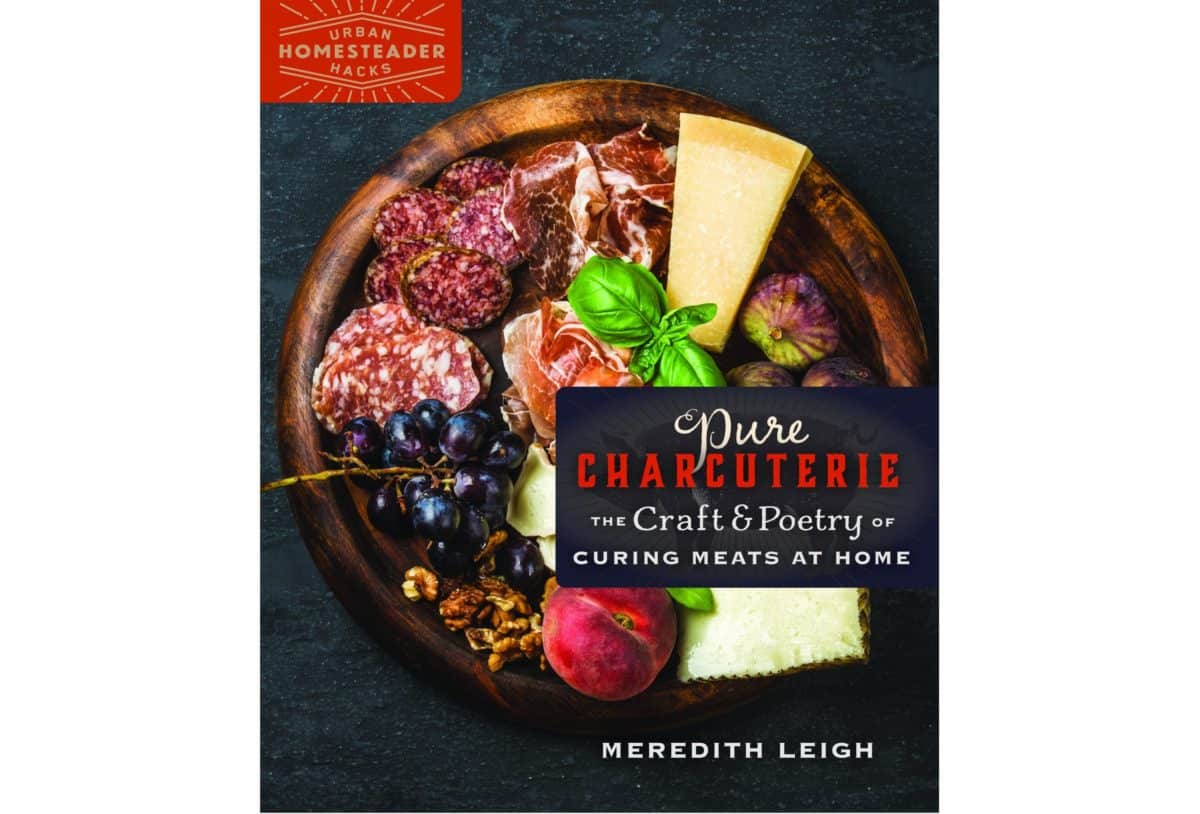These days, there’s scarcely a wine tasting, cocktail party or family gathering that does not include the serving of charcuterie. So it feels almost inevitable that Asheville, North Carolina-based cook, butcher and writer, Meredith Leigh, would have chosen this method of meat preservation as the subject of her tightly written, elegantly photographed book.
Not merely a cookbook, how-to manual, or memoir, Pure Charcuterie: The Craft & Poetry of Curing Meats at Home by Meredith Leigh (New Society Publishers 2018) is all three — and more. It’s a rumination about what is wrong — and right — with today’s foodways and a study of what fantastic flavors we could summon for our tables given an unlimited expanse of time and talent.
Leigh begins her book with a lovely argument for the value of growing what we eat and learning to preserve it. “I started growing food, and that became the grandest embodiment of real art that I had ever encountered. It still is.”
She follows with six chapters that start big picture but are expertly carved into practical detail before they close. In “On Collaboration,” she writes: “Embedded into every inch of dynamism that we can see with the naked eye, from the soil under the pig’s feet to the feed stuffs, to the muscle and the fat and the earth-made salt, there are unseen forces colluding.” By chapter’s end, we are building our own charcuterie cabinet and growing beneficial molds.
If you’ve ever wanted to cure your own bacon or brine a corned beef, stir up duck pate or churn out a rabbit sausage, you can learn how in this book. But Pure Charcuterie’s brilliance lies in the fact that you just might enjoy the ideas, the challenges and the techniques presented here even if you never intend to craft your own mortadella.
I found the supporting recipes — the miso, the creamy horseradish sauce, the pickled celery leaves — to be the most accessible. These were easy enough to make and flavorful enough to want to have on hand at all times. The horseradish sauce pairs deliciously with everything from latkes to ham roast. Leigh’s pimento cheese spread is a kicked version you’ll wish you’d been making for years.
Perhaps most meaningful are the moments when Leigh lays out the argument for ethical eating. Even when it’s time consuming. Even when it’s hard work.
Leigh’s first book, The Ethical Meat Handbook: Complete Home Butchery, Charcuterie and Cooking for the Conscious Omnivore, spoke directly to that topic. But her case is worth making again. And Leigh writes so poetically, so passionately, I found myself nodding and saying aloud, “Yes! Yes!” as I read her beautiful and courageous words.
For one, she lays to rest the tired saw of how we don’t want to know how the sausage is made. “Sausage is not a frightening food item. Dare I say, purer than a casserole?” “Real sausage? It is meat, fat and salt, y’all. That’s all. From there, it is a veritable playground for the inventive cook, one of the jumping-off places for creativity, and a vessel for profound flavor experiments.”
She also shines a spotlight on charcuterie as more than trend, more than impressive dish to wow dinner guests. “If our understanding of portion size, our patience for process, and our palate’s adoption of flavor must change, what better gateway do we have than charcuterie?”
Expect boundary-pushing recipes (Calabrese-Style Salami With Vanilla and Lardo), detailed explanations of curing and smoking methods and lovely quotes by the likes of Mary Oliver and Pablo Neruda.
If you’re like me, you’ll be moved by Leigh’s commitment, wowed by her expertise and delighted that Pure Charcuterie came into your kitchen. ![]()
